|
Competing in the 22" market is
not easy at the moment, with a large range of models being released from nearly
every manufacturer. With the market dominated pretty much exclusively by TN Film
based panels, prices of these models are very competitive, and the 22" diagonal
is quickly becoming a popular choice for the new buyer. Even the impressive
ViewSonic VX2245WM reviewed recently, with all its extras and features, is
priced in the UK at around £235. Other popular models like the Samsung SM226BW
and Dell E228WFP are also very well priced at around £270 and £247 respectively,
certainly giving the well established, smaller 20"WS models like the NEC 20WGX2
(~£340) and Dell 2007WFP (~£282) a run for their money. Obviously there is a
technology difference to consider here, but for many average users, the larger
screen size and lower price are more attractive.
Acer have stuck with their
normal formula with one of their 22" models, offering a basic and no-frills
design, but at a nice low price of around £190 in the UK. The specs of the
screen are fairly standard for the 22" market:
|
Size |
22"WS |
Colour Depth |
6-bit +FRC |
|
Resolution |
1680 x 1050 |
Viewing Angles |
170 / 160 |
|
Response Time |
5ms |
Panel Technology |
TN Film |
|
Contrast Ratio |
700:1 |
Interfaces |
DVI, VGA |
|
Brightness |
300 cd/m2 |
Colour |
Silver bezel with black base stand |
|
Special Features |
Tilt adjustment |
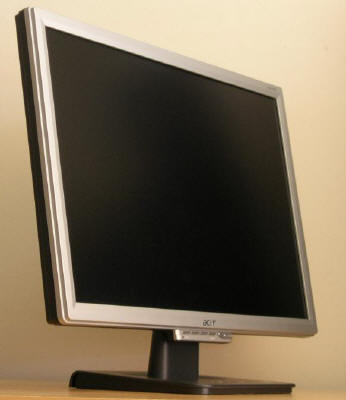
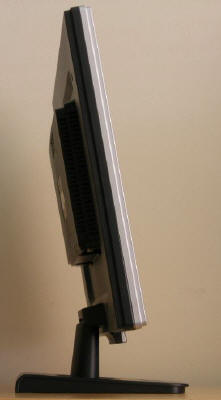
Above: Side view
of the Acer AL2216W. Click for larger images
The monitor came packaged well in a surprisingly
thin box. I had recently tested the
Viewsonic VX2245WM which had come in rather a huge case, but on the
contrary, the Acer was much more tightly packed. The screen came equipped with
all the usual cables you would expect, including power leads (for UK, Europe and
the US), DVI and VGA cables. The monitor features an internal power supply, so
no need for external power bricks here. The base of the screen came detached
from the main section of the monitor, but was easily slotted into place and
secured.
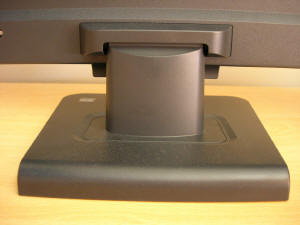
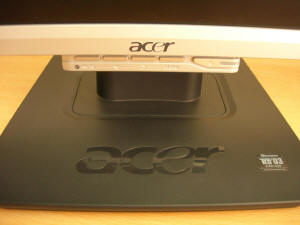
Above: rear view
of the stand (left) and detachable base section (right). Click for larger images
The back of the screen featured connections for
the power cable (usual kettle lead type), DVI and VGA cables. Sadly the screen
was lacking a cable tie which is rare nowadays.
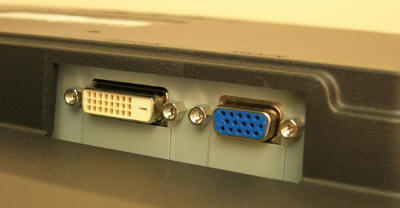
Above: DVI and
VGA interfaces
The screen features only a very basic tilt
function, tilting only about 10° maximum forwards and backwards from a vertical
position. Sadly there was no height adjustment available which I always think is
handy on any screen. Without this
manoeuvrability, the Acer AL2216W did sit
pretty low to the desk. This meant that, being tall myself, the tilt mechanism
only afforded me just about enough movement to be able to get the screen at a
comfortable level. This is probably not a problem for most users, and obviously
if you are choosing this screen, you know what to expect anyway. Fine for normal
office use I would say, but personally I would prefer to have seen a little more
flexibility.
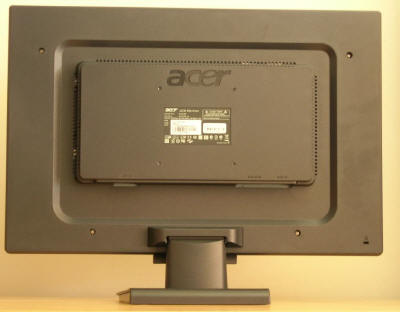
Above: Rear view
of the screen. Click for larger image
The design of the Acer is basic, but quite sleek I
thought. The actual thickness of the display is very thin and so the screen
would be ideal for wall mounting. The screen itself felt well built and sturdy,
but the stand did feel a bit flimsy. The stand was made of a thin section of
plastic and so moving the screen around didn't feel as smooth as it could have.
For instance, tilting the screen was a little stiff, and the base did not offer
the weight and support of some other models.
The screen uses a standard AR
coating rather than any glossy-type finish to the panel. Nevertheless,
despite being a no-frills offering, the AL2216W was a quite attractive display,
certainly not looking out of place in an office space.
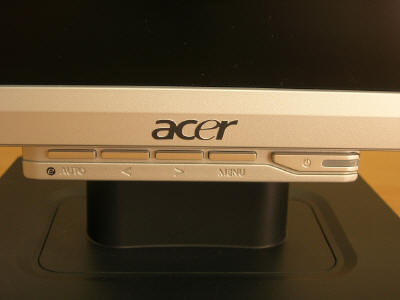
Above: OSD
selection buttons
The control buttons for the display sit on an
extra section below the centre of the bezel, rather than being built into the
bezel itself, or perhaps the side of the display. This did allow Acer to make
the bezel of the screen nice and thin around all edges, but did make the buttons
a little obtrusive. The OSD itself was nice and easy to navigate, and the
buttons were of a decent size and were responsive. There are the usual options
for brightness, contrast and interface. However, somewhat well hidden was the option for control of the colours at RGB levels.
At first glance, there was only
an option for colour temperature, with "warm", "cool" and "user" being
selectable. However, pressing the 'menu' button again having selected the "user"
setting brought up access to the RGB levels.
A single press of the 'auto' button brings up access to the colour
mode presets of the screen offering the usual options for "user", "text", "standard",
"graphics" and "movie" modes. These all featured a variety of preset colour
temperatures and brightness/contrast levels, designed for use in different
applications. The power LED glows green during use and is fairly dim and avoids
distraction. In standby mode it glows stronger (strangely!) in an orange colour.

Colour Quality and
Accuracy
The Acer AL2216W utilises an 6-bit +FRC TN
Film panel,
capable of producing a 16.2 million colour palette. The standard CCFL
backlighting used offers a gamut covering 72% of the NTSC colour space. An important
thing to consider for most users is how a screen will perform out of the box and
with some basic manual adjustments. Since most users won't have access to
hardware colorimeter tools, it is important to understand how the screen is
going to perform in terms of colour accuracy for the average user. I restored my graphics card to default settings
and set it to its standard profile. The AL2216W was tested at default factory
settings out of the box using the
LaCie Blue Eye Pro and their accompanying software suite.
Default settings of the screen were 77 brightness, 50 contrast. Colour
temperature was set to "warm" with the preset colour profile of "standard" being
selected through the 'auto' control button.

Acer AL22216W - Default Settings
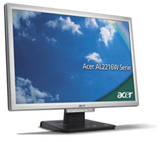

|
|
Default Settings |
|
luminance (cd/m2) |
205 |
|
Black Point (cd/m2) |
0.28 |
|
Contrast Ratio |
732:1 |
One thing which was nice, and quite rare, to see
from the Acer AL2216W at default settings was that brightness was modestly set
at 77% in the OSD. With a specified 300 cd/m2 maximum brightness, this meant that
the screen was pretty comfortable out of the box, without being overly bright, as
is common with many displays. Being set at a default colour profile of "warm" in
the OSD, the colours did feel nice, vibrant and even; with no obvious
tendency towards any particular colour. Testing the screen with the LaCie Blue
Eye Pro, a tool designed by Gretag Macbeth, gave some impressive results as
shown above.
Gamma was nearly at the default 2.2 measurement
for computer displays, being only 5% out at 2.3. Colour temperature was almost
spot on at 6596k, showing that the monitor colour temperature mode of
"warm" was a good preset mode to almost reach the desired 6500k 'daylight'
temperature. Luminance was considerably off the target 120 cd/m2 recommended
for LCD screens in normal lighting conditions at 205 cd/m2, but this did not feel nearly as
bright as some other default monitor settings I have tested.
The graph on the right shows the DeltaE values for
colours tested by the LaCie Blue Eye Pro. As a reminder, the lower these bars
down the Y-axis, the better, in terms of colour accuracy. For reference, LaCie
describe the DeltaE readings as:
-
If DeltaE >3, the color displayed is significantly different from the
theoretical one, meaning that the difference will be perceptible to the
viewer.
-
If DeltaE <2, LaCie considers the calibration a success; there remains a
slight difference, but it is barely undetectable.
-
If DeltaE < 1, the color fidelity is excellent.
The average DeltaE measurement of the AL2216W out
of the box was only 1.7, an extremely impressive result! For a TN Film panel,
even default monitor settings were very good here with only a slight difference
between the requested and displayed colours detectable. Luminance was recorded
at 205 cd/m2, and with a low black point of 0.28 cd/m2 the screen offered an
impressive 732:1 useable contrast ratio. I was very impressed with the AL2216W
at default settings and Acer have done a good job here. For all but professional
colour work, the AL2216W is very good at default settings. With a simple change
of the brightness setting you can easily correct the luminance level and have a
very decent quality of colours without even the need for much calibration.

Acer AL22216W - Calibrated Results

|
|
Calibrated Settings |
|
luminance (cd/m2) |
120 |
|
Black Point (cd/m2) |
0.23 |
|
Contrast Ratio |
522:1 |
I calibrated the screen with the LaCie
colorimeter, with the main change being a lowering of the brightness setting to
49% in the OSD, as compared with the default 77%. I adjusted the RGB levels
slightly while selecting the "user" preset mode for colour temperature.
Gamma was corrected to 2.2, and luminance was now recorded at 120 cd/m2 as
desired. Black depth was now reduced a little to 0.23 cd/m2, giving a contrast
ratio of 522:1. Black depth was good for a TN Film panel, being a little better
than the Viewsonic VX2245WM (0.26 cd/m2), but behind PVA panels I have tested.
Colour temperature was almost spot on at 6518k now, a slight improvement from
6596k at default settings using the "warm" colour profile mode. The monitor
gamut covered the sRGB colour space well, but no wider since only standard CCFL
backlighting tubes are used in this model.
Average DeltaE was reduced slightly to 1.6 and
while some tonal accuracy was improved (greys particularly), the main RGB shades
remained difficult to correct any further than that shown. I ran the calibration
process several times which helped tweak the accuracy, but the maximum DeltaE
still remained at 3.5. Still, a pretty decent performance anyway, but no massive
improvement in colour accuracy compared with default settings.
Testing the screen with colour gradients showed no
noticeable grading or banding of colours. While the screen does use Frame Rate
Control to boost the colour palette from the 6-Bit panel (to 16.2 million
colours), there were no obvious issues or artefacts from the use of this
technology. Again, a decent result.

Viewing Angles
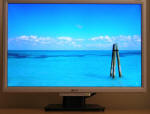

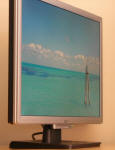


Above: (top) Viewing
angles shown from front and sides
(bottom) from above and from below. Click for larger images
As you can see from the above
images, the viewing angles are characteristic of those of a TN Film panel.
Horizontal viewing angles were actually good, with contrast shift not a major
problem up to about 65° away from a central view. Vertical viewing angles did
show the typical contrast shift especially from below, but I felt the viewing
angles of the AL2216W were actually pretty decent considering the technology
used. They were certainly of the newer generation of TN Film where viewing
angles have improved somewhat compared with some older screens. I didn't really
experience any major problems with viewing angles in most use, and it's possible
to use the screens tilt function to align your field of view quite nicely.

Panel Uniformity
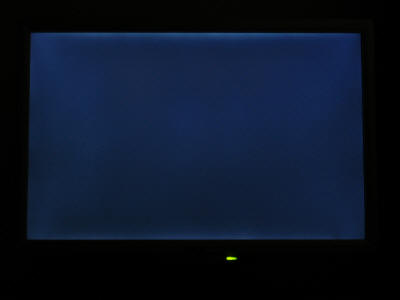
Click for larger
image
In our usual testing process I viewed an all black
screen in a darkened room, which allowed me to test the uniformity of the panel
and to examine whether any backlight bleed was evident. The screen performed
admirably in this regard, with only slight leakage noticeable at the top and
bottom of the screen. This can be seen on many LCD screens however, and is
inherent to the way they are produced and how CCFL backlight tubes are
positioned. On the AL2216W, this wasn't really an issue at all, and this goes to
show that despite the low price tag, Acer have not spared on production values.

Office and Windows Use
As I experienced with the Viewsonic VX2245WM
recently, the 22" diagonal size seemed to offer a comfortable and sensible size
screen by modern standards. Despite the screens quite large pixel pitch of
0.282mm, which some people find off-putting, I felt the text was of a nice size,
and perfectly clear and sharp. Both VGA and DVI interfaces produced a crisp
image, and picture quality was very comparable between the two. Once you have
used the "auto" adjust mode when using VGA, I'd say it would be pretty hard to
tell much, if any, difference between the two interfaces.
If you're using the
screen a lot for office use you will probably want to turn the brightness
setting down somewhat, as discussed in the colour accuracy and calibration
section of this review. Setting this to around 50% is much more comfortable in
normal lighting conditions, and should present no issues with eye strain that
you can experience from overly bright screens. The "text" preset colour mode
from the OSD was actually ever so slightly darker than my calibrated (120 cd/m2
luminance) "user" setting. It may well be worth while using this preset mode if
you prefer your "user" settings to be a little different.

Responsiveness and Gaming



Testing the screen using
PixPerAn software, and using my digital camera on the fastest shutter
speed, I captured an indication of the AL2216W's performance in fast moving
images. As a reminder, this is not a definitive guide to response time or how a
screen might behave in all situations and for all people. It is merely intended
as a comparative way of showing the responsiveness of a display using the same
test bed for each screen. As a reminder, the above images show best case (left)
and worst case (right) images taken from a large selection of camera shots.
The
Acer AL2216W felt
almost identical in these tests to the
Viewsonic VX2245WM I had tested recently. There was obvious blurring of the
moving car in the flag test, and a second "ghost" image was detectable to the
eye, and clearly on camera. Being that both models are 5ms rated, this is not
really any surprise, but confirms the similarities between the 5ms TN Film
generation. The AL2216W was perhaps a little faster than the
Samsung SM205BW (a 6ms rated screen) tested before; and at 5ms, the Acer is
probably suitable for many gaming needs. Being that the screen is TN Film based,
and is only listed at 5ms, with no G2G quoted figure, I would suggest that
this panel does not feature much in the way of RTC / overdrive technology. The
testing with PixPerAn seemed to confirm this analysis. I have included the NEC
20WGX2 as a reference since this is widely regarded as one of the fastest panels
in practice available today.
Testing the screen in games showed similar results
to the Viewsonic VX2245WM as expected. A keen eye will spot some slight
blurring, and certainly a degree of texture blur. Being 5ms rated, the screen
will be more than adequate for most users, but those who are more serious about
gaming may want to consider some of the other models available in the market
that use more RTC technology to boost grey to grey transitions. There are some
faster 22"WS models emerging like the Samsung SM226BW for instance which might
be a little more suited to faster gaming. However, the inherent problem with LCD
displays is that motion blur will always be perceived due to the way the human
eye sees the moving images. Many users are still waiting for that next
technology to bring TFT's closer to CRT's in this area, and technologies such as
BFI, MPA, 100Hz and scanning backlight are being developed to help. If you are
serious about gaming, these technologies may well help bridge that gap.
This article looks at technologies expected during 2007.
The monitor lacked any hardware aspect ratio
control, and so there were no options to maintain a 5:4 or 4:3 ratio, or run
with 1:1 pixel mapping. That obviously creates a problem for some people when
playing games which do not support widescreen format, and if using any external
devices which cannot control aspect ratio themselves.
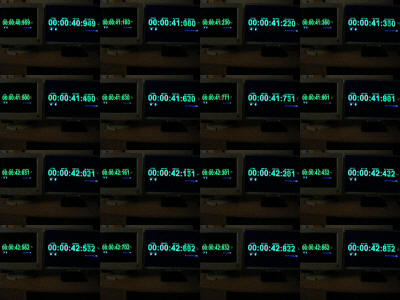
Click for larger
image
Testing the screen in clone mode with my test base
CRT monitor allowed me to measure the input lag of the AL2216W. All TFT's seem
to experience input lag compared with a CRT screen and this can often put pro
gamers off LCD technology screens. The Acer monitor showed an input lag of
typically 10ms, but did range up to 20ms in some cases. This isn't too bad for a
TFT screen and certainly should be no issue to the majority of users.

Movies and Video
Movie playback was adequate on the AL2216W. One of
the main considerations when choosing a screen for watching movies and video are
the viewing angles. Thankfully, despite being TN Film based, the Acer AL2216W
offered pretty decent fields of view, and side by side viewing was not really a
problem. If you are planning on watching a lot of movies on your screen, you may
want to consider a screen which is VA or IPS based, but if you are an occasional
viewer, and want to get a cheaper screen, the Acer is pretty decent.
Black depth was good and so darker scenes in
movies were mostly ok, with differences in shades detectable. However, dark
scenes can become a bit of a problem where viewing angles are concerned, since
vertical changes in contrast can make the scenes very difficult to see. Despite
the screen having quite good viewing angles for a TN Film panel, the use of this technology can still let the screen down if you don't take care to line
your view up. Movie noise was not really an issue from a sensible viewing
distance, and being 22" in size, you probably want to view from a couple of
metres away anyway.
The screen size was a nice step up from 19" and 20" models,
and offered added immersion to the experience. The widescreen format is
obviously preferable for movie viewing and so the format and large screen size
of the AL2216W were a positive factor. The decent panel uniformity meant that
viewing movies with black borders did not show any obvious backlight leakage,
something which can be distracting on some models.

Conclusion
The Acer AL2216W is certainly a very well priced
screen, and at only £190 in the UK it seems a bargain for a screen of this size.
The design and features are basic, and certainly no match for the impressive
functionality of models like the Dell monitor range, or others like the
Viewsonic VX2245WM. However, despite sparing on ergonomics and add-ons, Acer
have clearly not scrimped on other important areas. Panel uniformity is very
good, and responsiveness and viewing angles are adequate and in keeping with the
rest of the modern TN Film generation. Where the Acer really did impress was
with its colour rendering ability at default settings. Even out of the box, the
AL2216W performed very well, offering decent colour accuracy and a good contrast
ratio. I'd say this was certainly a good screen for anyone on a budget, or who
wants a basic but well performing monitor for the home or office.
|
Pros |
Cons |
|
Well priced |
Limited ergonomics, with only
a basic tilt function |
|
Good colour accuracy even
without calibration |
Basic design and no added
features |
|
Good panel uniformity |
|
|